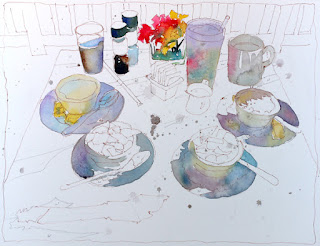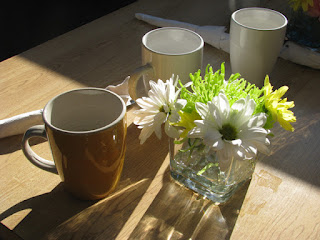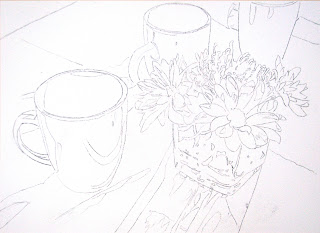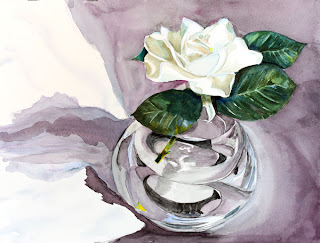In our class at ARThouse this past week, we are learning about loose painting in watercolor. Many people express a desire to paint more loosely and freely, because of the beautiful effects that can be obtained in watercolor with this approach. We briefly studied the style of Charles Reid, and discussed different ways to make your painting looser. Here are 10 Tips for makings your paintings looser in watercolor:
- Start with a simple contour drawing that is less precise and has more character than you usually might do. When you paint, don't feel that you have to stay within the lines!
- Use a bigger brush than you normally would. A good quality kolinski brush that points well will allow you to paint both large and small shapes.
- Use lots of water. Splash it around a little and let it drip! Don't worry about backruns.
- Usually mix your colors on the paper rather than on the palette. Allow one color to blend right into another even though they are in two different objects.
- Don't do too much glazing--you will muddy the picture. Try to paint each object with no more that two washes--one for the base color (or "local color") of the object, and one for any shadows.
- Don't try to make too many corrections. It will start to look over-worked!
- Keep your pigments fresh and bright. Clean your palette and change your water more often!
- Work a little faster than usual, although don't ever paint mindlessly! Concentrate on what you are going to do and then do it, with a minimum of brush-strokes and with an economy of means.
- Leave parts of the painting up to the viewer's imagination; just suggest areas and don't spell them out.
- Don't make things too perfect! The essence of loose painting is a brisk and spontaneous look. It may not be spontaneous, but it looks that way!
For my class demonstrations, I did two paintings based on still life scenes I photographed at an adorable little cafe in Venice, Florida, called the
Blu Island Bistro. We had breakfast there twice in January, and the light was streaming into the restaurant's sunroom just beautifully, illuminating the 1950's style "retro" table settings and decor. Here are the two photos I used as a basis for these paintings:
In this posting I will show the step-by-step demonstration of my painting process in working from the second photo, called
Blu Island Bistro--Fruit and Grits. In the next posting I will show the painting process for the first photo, called
Blu Island Bistro, Mugs and Mums.
Step 1. I made a black and white template of the image and transferred it to watercolor paper using Saral graphite transfer paper. I changed the composition a little by taking away the paper coffee cups, adding a white mug, and moving the sugar container in front of the flowers. I am working on a piece of 16x20" bright white Arches 140 lb cold-pressed paper that has been stretched and stapled to a homasote board.
Step 2. I don't want the graphite showing through my painting because it isn't very attractive (plain pencil would have been better to my mind). But I do want fine lines to show through. So I went over the whole drawing with a Sakura Micron 01 burnt sienna colored pen. These are both indelible and lightfast. I tried to give the drawing a little more character and a quirky style.

Step 3. I started painting the local colors that I observed on the objects, keeping in mind that most of them are in shadow. I feel that I already went a little too dark at this stage, which caused me to have to go darker than I wanted with the rest of the painting. During the whole painting process, I occasionally splattered paint and let it drip, plus allowed backruns to form. You can see all these pictures larger by clicking on one, and they will all appear larger in a new window on the blog. I will tell you right now all the colors I used in this painting (mostly Winsor & Newton): quinacridone red, Winsor red, hansa yellow (Da Vinci), cerulean blue, ultramarine blue, cobalt blue, Peacock blue (Holbein--a thalo blue), cobalt turquoise light, verditer blue, permanent violet, and quinacridone gold.

Step 4. Next I started to paint the large background wash (made with peacock blue, permanent violet, and a little yellow) on the mauve-colored formika table. I wish I had just pretended the table was white, by the way... This light wash will represent the local color of all the areas that are in sunlight. I allowed the paint to drip and run together in funny ways. The painting board was propped 2" high with a box of waxed paper to allow this broad wash to run down and even itself out.
Step 5. Now I mixed a darker version of the same colors and started a large wash representing all the shadow shapes on the table. It is hard to run such a large wash all at once, so I stopped at the bottom and wet the edge with clear water so that it would dry with a soft edge. That way I could continue the wash later and have it merge together without a hard edge.
Step 6. Here I have continued the shadow wash across the entire table. I regretted that it was a little too dark, but felt that putting very dark areas on the left and right side of the table would help in the end to make it look like a shadow on a light surface. I also painted the yellow sugar container, and the top rims of the glasses.
Step 7. Now I began painting the grits and fruit. In keeping with the desired looseness of the painting, I often allowed colors to blend together on the paper. I got too much blue in the grits, but fixed it later. For the doilies, I painted around their edge with a little medium blue, and then washed it away to create a slight shadow around the edge. I just suggested the doilie holes with little spots of color.

Step 8. Quite a bit has been done since the last step. I painted the other fruit bowl and some of the grits, the silver ware, and the shadow on the fence in the background. I also drew in two chairs and then painted the local color of the floor in the sunlight, which was a golden oak color. Something a little confusing about this scene is that the table was up against a glass wall. Outside the glass was a walkway with a white fence and a swimming pool beyond it. Although you cannot see the pool in the original photo, I eventually decided to suggest it with a teal background beyond the fence (see next step). Also here I splattered more paint on the paper and tried to create some drips, a la Charles Reid. It was hard to get the paint to run!
Step 9. Still working on the background here. I used cobalt turquoise light for the pool color.
Step 10. Now to get that dark color around the table, I used quinacridone gold, mixed toward the bottom with permanent violet. I decided to add more appearance of striped shadows coming from the 8 o'clock morning sunlight. I am happier with the painting now that some darks have been added around the table. The style is much "messier" than I would normally paint, but that was the idea. Hopefully it will work in the end...
Step 11. Here I added a shadow to the chair on the left, in keeping with the streaked shadow shapes coming across the table. I also decided to add a band of brown at the bottom to make the table have a better proportion and bring some of that brown all the way around the picture. Also I painted the lettering on the salt and pepper, and tweaked some of the objects. This picture has been complicated!
Step 12. In order to improve the composition a little, and make it less
symetrical, I added a coupon card for the Blu Island Bistro. To do
this, I taped around the area with 3M drafting tape, then used a Mr.
Clean Magic Eraser to remove the paint. (Cut off a little square of
this sponge-like material, dip it in water, and then rub the surface
gently to remove the paint. Blot with a paper towel).
Step 13. I was then able to pencil in, and then paint in, the writing on the coupon. I also expanded the bottom edge of the table. The painting is almost finished, at least enough for this blog posting. I will keep it in view for a few days and perhaps make minor improvements.
Susan Avis Murphy Fruit and Grits at Blu Island Bistro 14x18"
Self critique: As I said, I wish I had kept the large shadow area a lot lighter and perhaps more of a beige color. It seems unnaturally blue! It will be interesting to see how people react to this painting when they come into my studio. Perhaps I should have put the coupon at a different angle. I like the shadow stripes on the pool deck, but think the pool is too close for a pool! However the turquoise color adds a lot to the painting. I will probably do more paintings from this series of still life photos, but will return more to my usual style.
What do you think about the painting? Any ways it could have been done better? I would appreciate any feedback (please post your comments on the blog). Next posting in a few days will be a blow-by-blow account of the painting of the other photo above. Below is a sneak peak at the finished painting! Good luck with your painting-- Sue
Susan Avis Murphy Mugs and Mums 9x13"


















































